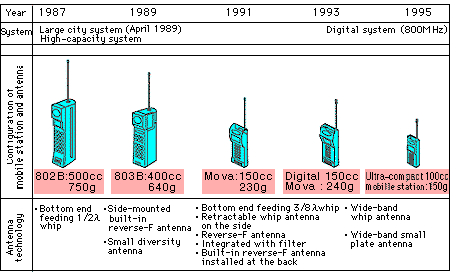Antennas, Base and Mobile Stations -2.Antennas for Base Stations and Portable Telephones
In a cellular mobile communications system, the same frequency is repeatedly used in different geographical areas to effectively utilize the limited number of frequencies. Because of this, the base station antenna must radiate the required radio waves within its cell while minimizing the emission of radio waves to other cells. Accordingly, the antenna is designed to control the main beam and direct it to the outer rim of its own cell by using beam tilt, while reducing sidelobe emissions that can interfere with neighboring stations.
Portable telephone systems require compact, lightweight and high-performance antennas. In recent years, two types of antennas (the transmission/reception whip antenna and the receive-only built-in antenna) are being used more and more in mobile terminals, along with the diversity transmission system. The monopole antenna is commonly adopted as a whip antenna, while the board-shaped reverse-F antenna is widely used as a built-in antenna. Efforts are being concentrated on making these antennas more compact and lightweight, as well as improving their performance and broadband capabilities.

Changes in NTT Cellular Phones
![]() Created 1999/03
Created 1999/03
